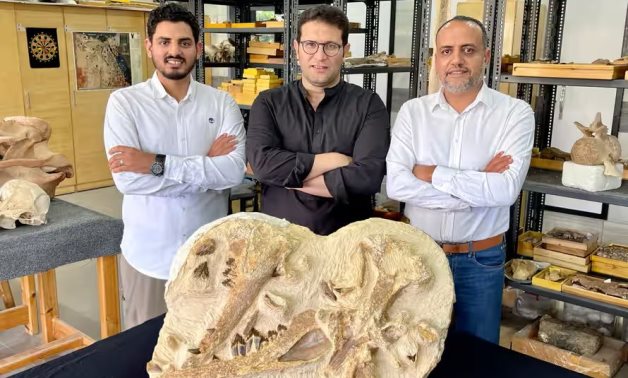
From left: Abdullah Gohar, Mohamed Sameh, and Hesham Sallam with the holotype fossils of Tutcetus rayanensis - Mansoura University vertebrate palaeontology centre
CAIRO - 11 August 2023: Tutcetus Rayanensis, a small 41 million year old whale, has been named after King Tutankhamen and Rayan Valley in Fayoum, where it was discovered.
“Egypt Can” show on DMC T.V. channel highlighted Thursday a study on Communications Biology journal about the ancient whale that came back into existence in the form of fossils in the bottom of the once-upon-a-time ocean in the low-land governorate of Fayoum.
Tiny by the standards of whales, Tutcetus was 2.5 meters long and weighed 187 kilograms. Blue Whales today measure 24-30 meters long and weigh 90,000 to 136,000 kilograms.
The Fayoum hosts Rayan Valley and the Whale Valley, the latter is so named because it is teeming with whale fossils.
The small whale belonged an an extinct family of whales, Basilosauridae, that lived fully in the water at a time when whales transitioned from land to sea. However, the family still had legs that remained from its ancestors that dwelled on land.
Interestingly, the study mentioned that whales that walked were small in size, perhaps explaining Tutcetus’ small scale since it also retained the legs. Alternatively, global warming during the late Lutetian thermal maximum may have led to the miniature size, as animals’ body masses, especially aquatic animals, are reduced when temperatures rise.
The project was mainly led by Mansoura University, as well as the American University in Cairo.
The Egyptian scientists are Mohammed Antar, Abdullah Gohar, Heba El-Desouky, Sanaa El-Sayed, and Hesham Sallam from the Vertebrate Paleontology Center in the university. Mohammed Antar from the Nature Conservation Sector, Egyptian Environmental Affairs Agency also contributed to the project.
Two U.S. scientists, Erik R. Seiffert and Alexander G. Claxton, from the University of Southern California, and Oklahoma State University Center for Health Sciences, respectively, also contributed to the project.
Comments
Leave a Comment